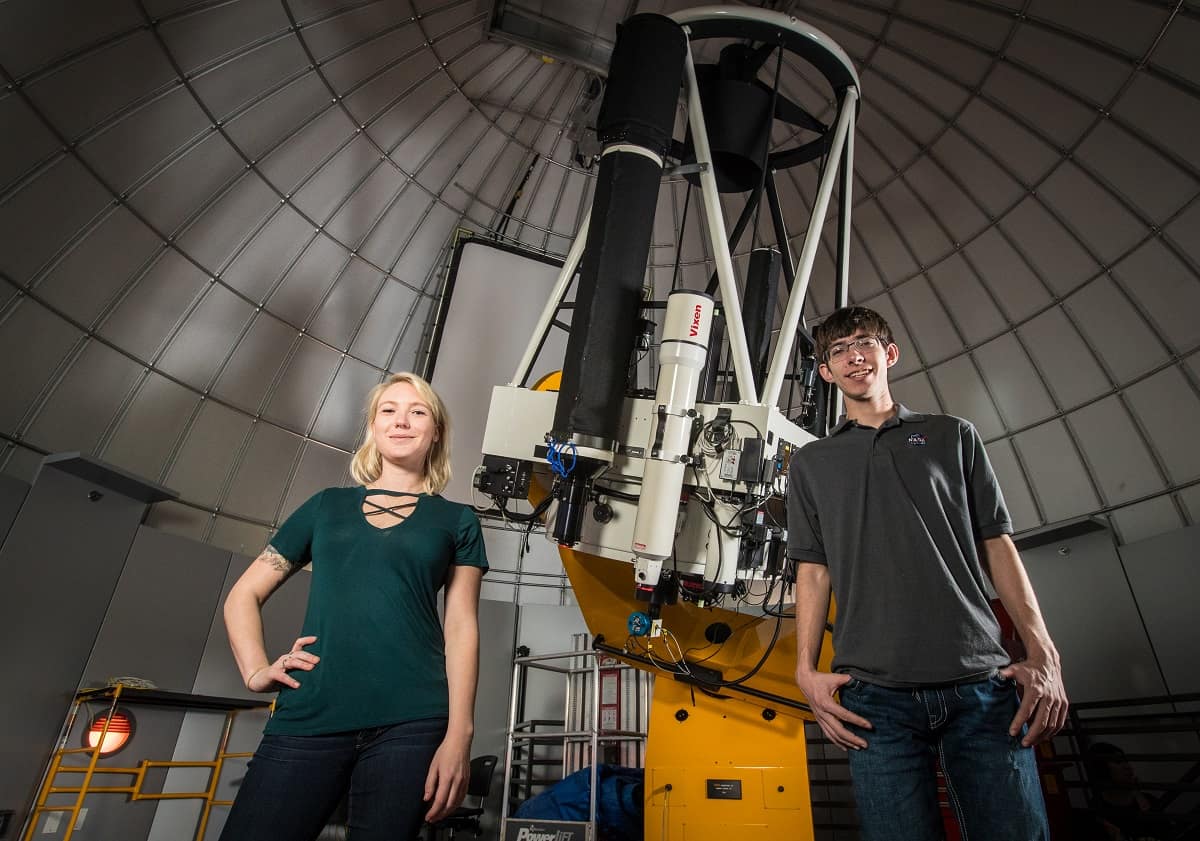Students Researching New Planets and Ages of Stars

Patrice Majewski remembers her mom waking her up as a child at 3 a.m. to lie on the front lawn and watch meteor showers. Looking up to the skies in Palm Coast, Fla., to see shuttle launches was also a regular occurrence.
Alexander Stone-Martinez was in the third grade when he became engrossed in a television mini-series about galaxies and space.
Those experiences sparked a fascination with stars and planets for Majewski and Stone-Martinez, now students at Embry-Riddle Aeronautical University’s Daytona Beach Campus. Both are currently working on projects to uncover data on binary stars, including possible new planets and the age of certain stars, through grants from NASA and the Florida Space Grant Consortium.
Working with Dr. Terry Oswalt, Chair of the Department of Physical Sciences at the Daytona Beach Campus, and Dr. Tomomi Otani, Visiting Instructor of Physical Sciences, the two students have been looking at stars on a computer in real-time using telescopes in Chile, Arizona and the Canary Islands operated by the Southeastern Association for Research in Astronomy (SARA). Embry-Riddle is the administrative institution for the 14-university consortium.
Their research will also be confirmed through Embry-Riddle’s 1-meter Ritchey-Chretien reflecting telescope, the largest university-based research telescope in Florida.
Both Majewski and Stone-Martinez are working on data from NASA’s Kepler Mission, which involved a space-based telescope that surveyed more than 100,000 sun-like stars. Through the grant, Embry-Riddle was assigned about 800 binary stars, which are stars that orbit each other as pairs.
The students’ preliminary results were presented recently at a meeting of the American Astronomical Society, along with presentations from several other Embry-Riddle students.
Majewski, who was in the U.S. Air Force for four and a half years and is now a reservist majoring in Space Physics, is finalizing research on 10 possible eclipsing binary stars, including two that appear to have a third object revolving around them.
“There is a fair chance that one of the pairs Patrice is studying has a planet revolving around it, and if so it will be one of those rare `Tatooine-like’ planets where you could see two suns in the sky if you were on it because of how they eclipse,” Dr. Oswalt said. “We haven’t quite yet ruled out the possibility it is just a very dim star, though there is definitely something there and Patrice is working hard to identify it.”
Majewski has been studying time variations of the eclipses to determine if a third-body exists. The two stars eclipse each other at slightly earlier or later times.
“That suggests something is orbiting those two stars and causing a gravitational pull that causes a delay or advance in the timing of the eclipse,” Majewski said. “If they were eclipsing each other and nothing was orbiting them, they would eclipse on a regularly scheduled time.”
Majewski is continuing her research to confirm her results and hopes to complete her project this spring semester.
“Through time variation of the eclipses, we are able to know not only the existence of a planet or a low mass star, but also the orbital information of it (i.e. if the orbit is circular or ellipse, the distance between the planet to the binary stars, etc.),” Dr. Otani added. “We can also use this method to search planets to many other eclipsing stars, so we want to find more `Tatooine-type’ planets with many interesting features.”
Majewski, a junior, later plans to combine her research skills from Embry-Riddle and her Air Force critical-thinking and problem-solving experience in operations intelligence, either continuing in a research assistant or program management job after graduation in the space field or seeking a master’s degree.
Stone-Martinez, a junior majoring in Astronomy and Astrophysics, meanwhile, is researching the ages of stars and in particular the accuracy of the Gyrochronology method, which has been tested on star clusters in previous studies. Stone-Martinez has been examining 290 binary stars from the Kepler Mission.
“There are other methods to determine a star’s age, but this one may be more accurate,” said Stone-Martinez.
He has found ages for about 20 pairs of stars ranging from about 250 million years old to 4.5 billion years old, and he hopes to extend the method to much older stars.
“It’s fascinating to learn the ages of the stars. This project is hopefully a gateway to conduct more research in other areas as well,” Stone-Martinez said.
Determining the age of stars is difficult.
“We can determine their velocity, temperature, luminosity, mass and composition with the tools we have on the backend of our telescope, but the age is sort of a hidden quantity,” Dr. Oswalt said.
One clue to determining the age of a star is how active it is. Like people, Dr. Oswalt said, stars become less active as they age. When stars rotate, they generate a magnetic field that causes spots and flares and other signs of activity. The faster stars rotate, the younger they are, and the more spots and dips in light they will exhibit.
Dr. Otani said this is just the beginning of the research with Stone-Martinez and other students observing hundreds of binary stars using the Kepler Space Telescope.
“When we know the precise ages for many stars in our galaxy, we will be able to understand more about the Milky Way’s formation history,” Dr. Otani said.
Final results for both projects will be completed by the end of the spring semester and additional grants are being sought as the research continues.
Some other Embry-Riddle students involved in the American Astronomical Society meeting included recent graduate Will Fanning, whose research presentation was “Exoplanet Detection Synergies between Gaia and the WFIRST Coronagraph” and students Adam Moss, “Analyzing the Effects of Stellar Evolution on White Dwarf Ages”; David PeQueen, "Characterizing Giant Exoplanets through Multiwavelength Transit Observations: HAT-P-5 b" and Sarena Robertson, “Potassium Emissions in the Lunar Exosphere.”

 Deborah Circelli
Deborah Circelli